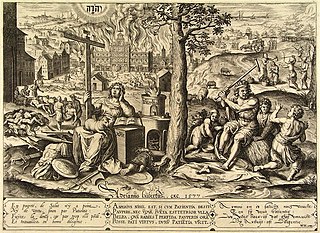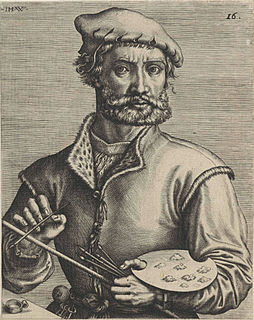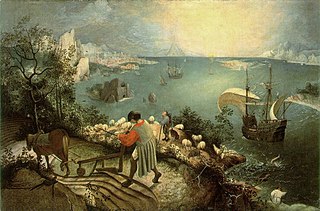
Pieter Brueghelthe Younger was a Flemish painter, known for numerous copies after his father Pieter Bruegel the Elder's work as well as his original compositions. The large output of his studio, which produced for the local and export market, contributed to the international spread of his father's imagery.

Pieter Bruegelthe Elder was the most significant artist of Dutch and Flemish Renaissance painting, a painter and printmaker, known for his landscapes and peasant scenes ; he was a pioneer in making both types of subject the focus in large paintings.

Jan Brueghelthe Elder was a Flemish painter and draughtsman. He was the son of the eminent Flemish Renaissance painter Pieter Bruegel the Elder. A close friend and frequent collaborator with Peter Paul Rubens, the two artists were the leading Flemish painters in the first three decades of the 17th century.

Cornelis Cort was a Dutch engraver and draughtsman. He spent the last 12 years of his life in Italy, where he was known as Cornelio Fiammingo.

Jan Collaert the Elder or (I), Hans Collaert the Elder or Johannes Collaert was a Flemish printmaker, publisher, draftsman, tapestry designer, glass painter and designer and engraver of swords. He was the founder of a dynasty of engravers that would play a significant role in establishing Antwerp as one of the leading centres for printmaking in Europe in the second half of the 16th century and the early 17th century.

Pieter Coecke van Aelst or Pieter Coecke van Aelst the Elder was a Flemish painter, sculptor, architect, author and designer of woodcuts, goldsmith's work, stained glass and tapestries. His principal subjects were Christian religious themes. He worked in Antwerp and Brussels and was appointed court painter to Charles V, Holy Roman Emperor.

PhilipGalle was a Dutch publisher, best known for publishing old master prints, which he also produced as designer and engraver. He is especially known for his reproductive engravings of paintings.

Jan Snellinck or Jan Snellinck (I) was a Flemish painter, draughtsman and designer of tapestries, prints and frescoes. He is known for his large altarpieces and was also recognized as a leading battle painter in his time. Snellinck was active as an art dealer and art collector.

Dutch and Flemish Renaissance painting represents the 16th-century response to Italian Renaissance art in the Low Countries. These artists, who span from the Antwerp Mannerists and Hieronymus Bosch at the start of the 16th century to the late Northern Mannerists such as Hendrik Goltzius and Joachim Wtewael at the end, drew on both the recent innovations of Italian painting and the local traditions of the Early Netherlandish artists. Antwerp was the most important artistic centre in the region. Many artists worked for European courts, including Bosch, whose fantastic painted images left a long legacy. Jan Mabuse, Maarten van Heemskerck and Frans Floris were all instrumental in adopting Italian models and incorporating them into their own artistic language. Pieter Brueghel the Elder, with Bosch the only artist from the period to remain widely familiar, may seem atypical, but in fact his many innovations drew on the fertile artistic scene in Antwerp.

Hans Bol or Jan Bol, was a Flemish painter, print artist, miniaturist painter and draftsman. He is known for his landscapes, allegorical and biblical scenes, and genre paintings executed in a late Northern Mannerist style.

Hieronymus Cock, or Hieronymus Wellens de Cock was a Flemish painter and etcher as well as a publisher and distributor of prints. Cock is regarded as one of the most important print publishers of his time in northern Europe. His publishing house played a key role in the transformation of printmaking from an activity of individual artists and craftsmen into an industry based on division of labour. His house published more than 1,100 prints between 1548 and his death in 1570, a vast number by earlier standards.

Dominicus Lampsonius was a Flemish humanist, poet and painter. A secretary to various Prince-Bishops of Liège, he maintained an extensive correspondence with humanists and artists at home and abroad. His writings on Netherlandish artists formed an important contribution to the formation of the so-called Netherlandish canon.

Mayken Verhulst, also known as Marie Bessemers, was a sixteenth-century miniature, tempera and watercolor painter, identified by Lodovico Guicciardini in 1567 as one of the four most important female artists in the Low Countries. She was actively engaged in the workshop of her husband, Pieter Coecke van Aelst, posthumously publishing his works. While she is recognized as an exceptionally skilled artist, little is known about her works or life as there are few surviving attributable sources of information.

Jan Baptist Barbé or Jan-Baptist Barbé (1578–1649) was a Flemish engraver, publisher and art dealer active in Antwerp. He is known for his engravings after his own designs as well as for his reproductive engravings.

Petrus, or Pieter de Jode I or Pieter de Jode the Elder, was a Flemish printmaker, draughtsman, publisher and painter active principally active in Antwerp. He was active as a reproductive artist who created many prints after the works of leading painters and was in addition a prolific designer of prints for Antwerp publishers.

Hubert Goltz or Goltzius was a Renaissance painter, engraver, and printer from the Southern Netherlands. He is not to be confused with the much more famous Hendrik Goltzius, who was his cousin, once removed.

The Master of the Small Landscapes was a Flemish artist from the mid-16th century known for his landscape drawings. The name of this unidentified artist is derived from a series of 44 prints of landscapes that were created after the artist’s drawings, some of which have been preserved. Together with the work of Pieter Bruegel the Elder, the drawings of the Master played an important role in the evolution of Northern Renaissance landscape art from the world landscape into an independent genre.

Volcxken Diericx was a Flemish print maker and publisher. She and her husband Hieronymus Cock founded an important publishing house in Antwerp, which she continued to operate after the death of her husband.

Alexander Voet the Elder or Alexander Voet I was a Flemish engraver, print artist and publisher. He was one of the leading engravers and publishers in Antwerp in the middle and second half of the 17th century. He operated a large workshop in which sixty to seventy collaborators took care of the entire process of printmaking, printing and publishing.

Pieter van der Heyden was a Flemish printmaker who is known for his reproductive engravings after works by leading Flemish painters and designers of the 16th century.




















